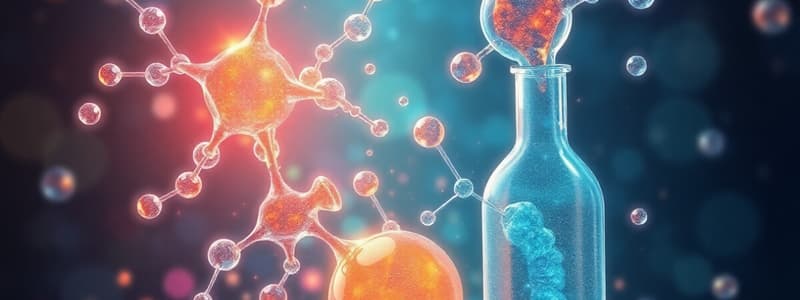Podcast
Questions and Answers
What does the suffix –ose indicate in carbohydrates?
What does the suffix –ose indicate in carbohydrates?
- Sugar (correct)
- Lipid
- Starch
- Protein
Monosaccharides contain more than 10 sugar units.
Monosaccharides contain more than 10 sugar units.
False (B)
What is the general formula for monosaccharides?
What is the general formula for monosaccharides?
Cn(H2O)n
Carbohydrates derive from aldehyde or _____ derivatives of polyhydric alcohols.
Carbohydrates derive from aldehyde or _____ derivatives of polyhydric alcohols.
Match the types of carbohydrates to their number of sugar units:
Match the types of carbohydrates to their number of sugar units:
Which of the following monosaccharides contains 5 carbon atoms?
Which of the following monosaccharides contains 5 carbon atoms?
All hexoses are aldohexoses.
All hexoses are aldohexoses.
What is the general formula of disaccharides?
What is the general formula of disaccharides?
A monosaccharide containing 4 carbon atoms is called a ______.
A monosaccharide containing 4 carbon atoms is called a ______.
Match the disaccharides with their components:
Match the disaccharides with their components:
Flashcards
Carbohydrates
Carbohydrates
Aldehyde or ketone derivatives of polyhydric alcohols, or any substances derived from them.
Monosaccharides
Monosaccharides
Simplest carbohydrates, single sugar units.
General formula of Monosaccharides
General formula of Monosaccharides
Cn(H2O)n
Aldoses
Aldoses
Signup and view all the flashcards
Ketoses
Ketoses
Signup and view all the flashcards
Disaccharides
Disaccharides
Signup and view all the flashcards
Glycosidic bond
Glycosidic bond
Signup and view all the flashcards
Study Notes
Carbohydrate Chemistry
- Carbohydrates are aldehyde or ketone derivatives of polyhydric alcohols, or any substances derived from them
- Carbohydrate is another name for carbon and water (C + H₂O)
- For every carbon atom, there is one molecule of water or two hydrogen atoms and one oxygen atom.
- They are also called saccharides.
- Carbohydrates make up approximately 60% of our diet.
- Carbohydrates provide energy.
- Carbohydrates combine with lipids to form glycolipids or with proteins to form glycoproteins. These combinations become part of the cell membrane.
- The suffix "-ose" means sugar.
Classification of Carbohydrates
- Carbohydrates are classified according to the number of sugar units.
- Monosaccharides: one sugar unit (e.g., glucose, fructose)
- Disaccharides: two sugar units (e.g., sucrose, lactose)
- Oligosaccharides: three to ten sugar units
- Polysaccharides: more than ten sugar units
Monosaccharides
- These are the simplest carbohydrate units.
- Their general formula is Cₙ(H₂O)ₙ.
- They can be divided into aldoses (aldehyde group) and ketoses (ketone group).
- Classification is based on the number of carbon atoms:
- Triose: 3 carbon atoms (e.g., glyceraldehyde, dihydroxyacetone)
- Tetrose: 4 carbon atoms (e.g., erythrose, erythrulose)
- Pentose: 5 carbon atoms (e.g., ribose, arabinose, xylose, lyxose, ribulose, xylulose)
- Hexose: 6 carbon atoms (e.g., glucose, galactose, mannose, fructose)
- Heptose: 7 carbon atoms (e.g., sedoheptulose)
Importance of Pentoses
- Ribose and deoxyribose are components of RNA and DNA
- Ribose is part of high-energy phosphate compounds (ATP, GTP)
- Ribose is also found in coenzymes like NAD, NADP, and flavoproteins.
- Arabinose and xylose are components of glycoproteins in plants and animals.
- Lyxose is part of lyxoflavin, found in human heart muscle.
Importance of Hexoses
- Glucose: major energy source in mammals
- Fructose: main sugar in semen
- Galactose: essential for synthesizing lactose (milk sugar) in lactating mammary glands.
- Mannose: component of many glycoproteins.
Disaccharides
- Formed by condensation of two monosaccharides linked by a glycosidic bond
- General formula: Cₙ(H₂O)ₙ₋₁
- Key disaccharides:
- Maltose: two α-glucose molecules linked by an α(1→4) glycosidic bond found in malt and produced by starch digestion.
- Isomaltose: two α-glucose molecules linked by an α(1→6) glycosidic bond formed during starch and glycogen digestion by amylase.
- Cellobiose: two β-glucose molecules linked by a β(1→4) glycosidic bond obtained by cellulose hydrolysis in plants.
- Lactose: β-glucose and β-galactose linked by a β(1→4) glycosidic bond. Found in milk.
- Sucrose: α-glucose and β-fructose linked by an α(1→2)β glycosidic bond. Found in cane and beet sugar, pineapple, and carrots.
Polysaccharides
- Composed of more than 10 monosaccharides linked by glycosidic bonds.
- Homopolysaccharides: consist of one type of monosaccharide:
- Starch: storage carbohydrate in plants. Consists of amylose (15-20% of the granule) and amylopectin.
- Glycogen: storage carbohydrate in animals. Branched structure.
- Cellulose: structural component of plant cell walls. Cannot be digested by most mammals.
Studying That Suits You
Use AI to generate personalized quizzes and flashcards to suit your learning preferences.




